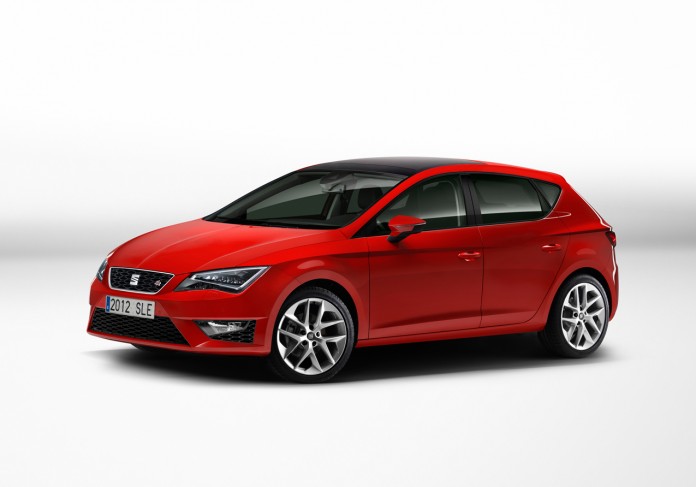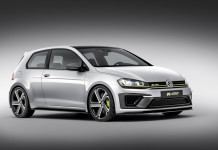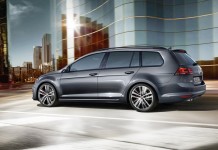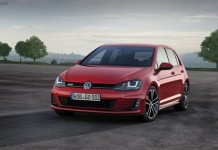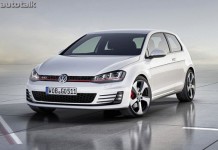When Volkswagen updates its venerable Golf, it is only a matter of time before the many cars based on the Golf platform receives updates as well. Such is the case for the new Seat Leon. The Spanish car company has been building its own, sportier, version of the Golf for many years now and this new angular design is one of the nicest yet.
When it hits the market, it will be available with a pair of diesels, a 1.6 and 2.0, with five more powerplants to arrive next year.
Non of this is any importance if you live here in the USA however, as like all Seats before, this is a Euro model lineup. Don’t let that bad news deter you from checking out the high resolution gallery we have posted below of the new Seat Leon. If you want some more information on the new car, feel free to read the full press release included below.
SEAT today introduces the stunning new Leon. Seamlessly combining beauty and practicality, the all-new Leon is the epitome of desirability. Completely redesigned from the ground up, the third generation Leon is packed full of high-end technology, utilising a cutting edge chassis, advanced infotainment systems and sophisticated driving aids. Each of the engines combines powerful dynamics with outstanding efficiency.
The availability of full-LED headlamps for the new, third generation Leon is a pioneering move by SEAT – a first in the family hatchback class. This technology combines striking design with exceptional illumination.
“The new Leon condenses all the strengths of the SEAT brand more than ever before. It is a car with sporting character and wide-ranging strengths. It brings quality and technologies from the full-size class into the compact segment. The Leon is a decisive step in SEAT’s brand and growth strategy. It will be launched towards the end of this year as a five-door and will subsequently grow with further variants into a fully-fledged family,” said James Muir, President of SEAT S.A.
“With the all-new Leon, we have designed and developed a car which perfectly captures the meaning of ‘Enjoyneering’. This compelling mix of design, technology, athletic performance and premium quality is certain to seduce existing customers, as well as bringing a new generation of car-buyers to the brand,” he added.
The new Leon is compelling for its excellent practicality. It combines a more compact exterior with a more spacious interior. The premium materials and the level of craftsmanship place the Leon squarely at the forefront of the competitive field.
Every power unit is among best-in-class for efficiency and emissions, with the highlight being the 1.6 TDI with start/stop. It has an average fuel consumption of just 74.3 mpg and a CO2 figure of just 99 g/km.
“The new Leon is an all-new car and opens a new chapter for SEAT. It combines SEAT’s dynamic new design language with the latest technology. Fine details and precise design, especially in the interior, reflect the high standard of craftsmanship of the new Leon,” explains Dr. Matthias Rabe, Vice-President of Research and Development for SEAT S.A.
Dr. Rabe added: “Built on the Volkswagen Group’s MQB shared architecture which benefits from systematic lightweight design, the new Leon offers an impressive performance, with low CO2 emissions and fuel consumption. In summary, the new Leon provides emotional driving fun, excellent efficiency, a stunning design and a high degree of utility.”
Design: simply stunning
“Thanks to its dynamic and assured character, the new SEAT Leon inspires a self-confident stance. It has a decisive look,” says Alejandro Mesonero-Romanos, Head of SEAT Design. “It keeps a high degree of formal beauty and sportiness.”
He adds: “It has extremely well proportioned volumes, with a slight shift of the visual weight of the cabin over the rear wheels, while keeping a very fluid transition between the front wing and the cabin. The surfaces have been severely sculpted all around in order to increase its tri-dimensional appeal, thanks to the effects of light and shadow. Its character lines show pure assertiveness, like for instance the outer shape of the headlamps and tail lamps. All in all, I strongly believe that the new Leon is full of character.”
At 4.26 metres long, the new Leon is around five centimetres shorter than its predecessor, yet the wheelbase is up by almost six centimetres. This clever packaging enables short overhangs and enhances the strong visual presence of the wheels, while giving practical benefits such as improved interior space, particularly for rear seat passengers, as well as in the luggage compartment.
The angular line of the headlamps is a typical feature of the new SEAT design language, while also being perfectly integrated into the Leon’s sculptural form. Full-LED lights are available for the first time in the compact class. The new headlamps give an unmistakable look to the front end of the Leon. Additionally, the new Leon now has a distinctive signature appearance thanks to the fitment of LED daytime running lights.
From the side, the new SEAT Leon looks like a precisely executed sculpture on wheels. The characteristic, unbroken ‘Línea Dinámica’ runs rearwards over the wheel arches. It is reminiscent of the tension of a well-trained muscle. The trapezoidal C-pillars are characteristic to the Leon, as are the short, upwards-pointing third windows.
The rear end of the new SEAT Leon has been intensively modelled; the large logo serves as an opener for the rear hatch. The slightly wedge-shaped rear light clusters highlight the car’s width and are also available in LED technology.
The interior: comfortable and premium
The elegant exterior design of the new Leon continues into the interior, which has a clear, light and uncluttered look. The dashboard is unconventional and elegant, with a two-tone design that makes it appear to float in mid-air. Fine details underscore the Leon’s high standard of craftsmanship – details such as the large air vents, the controls for the air conditioning and the three-dimensional form of the trim elements. The luggage compartment has a volume of 380 litres, around 40 litres more than the preceding model.
Describing the interior, Alejandro Mesonero-Romanos, Head of SEAT Design, said: “We set ourselves the objective of developing an interior which would give an expressive, elegant and welcoming ambience. The quality of the material, the fit and finish and the attention to details is at least as good as you can find in the segment above.”
“The design of the dashboard respects our new interior philosophy, with a strong driver orientation. This enhances the ergonomics while giving the design an attractive, sporty feeling. The whole has been designed so the new Leon and its driver feel as one.”
The body shell: lightweight and solid
The new SEAT Leon uses a new vehicle architecture that enabled development engineers to position the front axle 40 millimetres further forward. The results are a longer wheelbase and a balanced distribution of axle load – factors that significantly benefit comfort and sporty handling.
Thanks to advanced construction techniques and the use of lightweight materials in the body’s manufacture, the overall weight has been reduced by 90 kilograms compared with the previous version.
Drive: powerful and efficient
The new Leon will be powered by a series of powerful and fuel-efficient TDI and TSI engines, ranging from 1.2- to 2.0 litres. All engines feature direct injection and turbocharging, and have been engineered for low internal friction and fast warm-up. Compared with their respective predecessors, their fuel consumption is down by up to 22 percent.
The 1.6 TDI generates 105 PS (104 bhp) and 250 Nm (184 lb.ft) of torque. In the Ecomotive version with start/stop system and brake energy recuperation, it returns an astonishing 74.3 mpg on average, equating to just 99 g/km CO2*. The extensively re-engineered 2.0 TDI returns a hugely impressive 70.6 mpg* in the Ecomotive version, yet develops 150 PS (148 bhp) and 320 Nm (236 lb.ft) of torque. It is a powerful driving force for the Leon.
SEAT will rapidly expand the engine line-up. Early 2013 will see the arrival of the 1.2 TSI in two versions with 86 PS (85 bhp) and 105 PS (104bhp); a 1.4 TSI with 122 PS (120 bhp); and at the top of the petrol range, a 1.8 TSI with 180 PS (178 bhp) and a combination of direct and manifold injection. The diesel line-up will be augmented by the 1.6 TDI with 90 PS (89 bhp) and a powerful, range-topping 2.0 TDI with 184 PS (181 bhp). It delivers a maximum torque swell of 380 Nm (280 lb.ft).
Depending on the engine, transmission options range from five- and six-speed manual gearboxes or the renowned six- and seven-speed DSG dual-clutch gearboxes.
The chassis: dynamics with comfort
The chassis of the new SEAT Leon scores high for its sporty and agile character. Its front suspension features a MacPherson front axle with sub-frame, while the rear uses torsion beam suspension for engines up to 150 PS (148 bhp). More powerful variants use a multi-link construction that handles longitudinal and transverse loads discretely.
The new SEAT Drive Profile for the Leon FR allows the driver to vary the characteristics of the power steering, throttle control and engine sound (FR versions only) via a sound actuator using three modes: eco, comfort and sport. There is also a facility to tailor the settings according to the driver’s preference. The interior ambient LED lighting changes according to the selected setting: white in eco and comfort modes, and red in sport.
Infotainment: modern and flexible
In the new Leon, SEAT offers a full range of up-to-date infotainment solutions. The basis is formed by the Easy Connect operating system, which controls the SEAT Sound System entertainment and communication functions, as well as a wide array of vehicle functions, via a touch-sensitive screen in the cockpit.
The entry level is the Media System Touch in the Reference* line, which includes a CD radio with an SD card slot, four speakers and a five-inch touch screen. Style* and FR come with the Media System Colour featuring more in-screen colours and higher quality, with a CD drive and six speakers as standard (eight speakers in the FR). It connects external devices via Bluetooth, USB or aux-in. Its five-inch colour touch screen also controls vehicle functions.
(*UK trim levels TBC)
The Media System Plus systems has a 5.8-inch touch screen with three-dimensional graphics in high definition, iPod connectivity, an optional DAB tuner, and voice recognition. The system comes with eight speakers. This system incorporates the navigation system, which also shows navigation information in the colour display between the speedometer and rev counter and can be controlled by voice recognition. The SEAT Sound System has a clear, crisp sound reproduction thanks to its 10-speaker and sub-woofer set-up.
Driver assistance systems: groundbreaking
The new Leon sets benchmarks when it comes to the available driver assistance systems. The drowsiness detection feature recognizes when the driver is losing concentration and suggests taking a break. Additionally, an advanced camera mounted behind the rear-view mirror manages both the Full Beam Assistant, which switches automatically between full and dipped beam, and the ‘Heading Control’ lane-keeping assistant, which makes slight corrections to the electro-mechanical power steering to prevent the driver from crossing over lane markings.
New SEAT logo
Another all-new element of the Leon is the logo on its grille, rear and steering wheel. The Leon will be the first car to wear the company’s newly refreshed badge.
Sporting a cleaner, purer design, the new SEAT logo represents the precision and elegance of the brand’s design language, while also reflecting the company’s engineering and quality leadership. The introduction of the new SEAT logo across all of the company’s visual material and locations will begin from Paris Motor Show in September.
About SEAT
SEAT is the only company in its sector with the full-range capacity to design, develop, manufacture and market cars in Spain. A member of the Volkswagen Group, the multinational has its headquarters in Martorell (Barcelona), exporting approximately 80% of its vehicles to 75 countries. SEAT is market leader in Spain, and in 2011 had a total turnover of more than 5.0 billion euros, with overall deliveries amounting to 350,000 units.
SEAT Group employs more than 14,000 professionals at its three production centres in Barcelona – Zona Franca, El Prat de Llobregat and Martorell, where it manufactures the highly successful Ibiza and Leon, amongst other models. The Volkswagen Group production facility at Palmela in Portugal supplies the SEAT Alhambra and the factory in Bratislava (Slovakia) manufactures the SEAT Mii.
The Martorell site also features a Technical Center, a ‘knowledge hub’, bringing together more than 900 engineers whose goal is to be the driving force behind innovation for the number one industrial investor in R&D in Spain. In line with its declared commitment to environmental protection, SEAT undertakes and bases its core activity on sustainability, namely reduction of CO2 emissions, energy efficiency, as well as recycling and re-use of resources.

